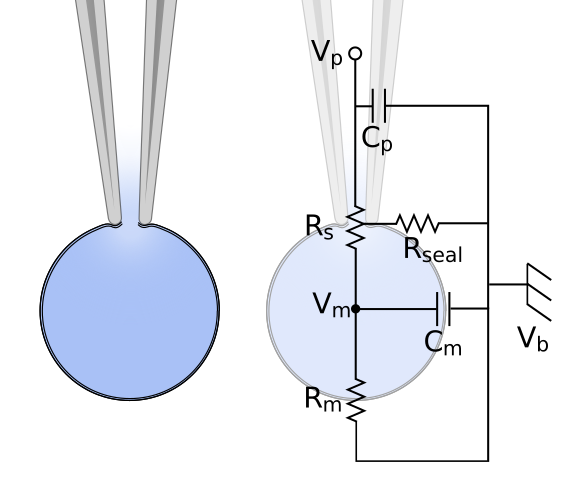Overview¶
The patch clamp technique achieves superior recording fidelity by creating a high-resistance seal between the pipette glass and the cell membrane, then rupturing the membrane within the lumen of the pipette to allow measurement of electrical signals internal to the cell. In the methods we describe, a thin slice of brain tissue is held in a small chamber perfused with warm, oxygenated fluid, which approximates cerebrospinal fluid. This arrangement keeps the brain slice alive for several hours after dissection, during which the experimenter will attempt to patch neurons within the slice. The recording chamber is mounted on a microscope stage to allow the experimenter to visually identify cells within the slice. Glass patch pipettes, filled with an electrode solution approximating the composition of cytosol, are then positioned using precise micromanipulators to form a seal with the cell membrane.
By applying suction to the patch pipette, the membrane is ruptured, granting electrical access to the cell interior. However, this access is imperfect due to the electrical characteristics of the pipette. The goal of patch clamp, in the most general sense, is to measure and manipulate the voltage Vm and resistance Rm of the patched neuron (figure 1). This goal is confounded by the combination of electrical resistance at the tip of the pipette Rs and capacitance across the cell membrane Cm and pipette walls Cp. These confounds are addressed through a variety of techniques that are discussed throughout the chapter.

Figure 1. Schematic of glass electrode patched onto cell with equivalent circuit diagram. Vp: Voltage inside pipette; this is the voltage controlled or measured by the amplifier, less the electrochemical junction potential. Cp: Pipette capacitance; typically a few picofarads. Rs: Series (or access) resistance; this is the resistance separating the pipette from the cell body and is due mainly to the narrow pipette tip and organelles that may be blocking it. Rseal: Seal resistance; the resistance of the region of contact between the pipette and the membrane. To make quality recordings, this must be > 1 GΩ. Vm: Membrane voltage; the voltage of the interior of the neuron relative to the bath. Cm: Cell membrane capacitance. Rm: Cell membrane resistance; also called input resistance. Vb: Bath voltage, as measured by the ground electrode.